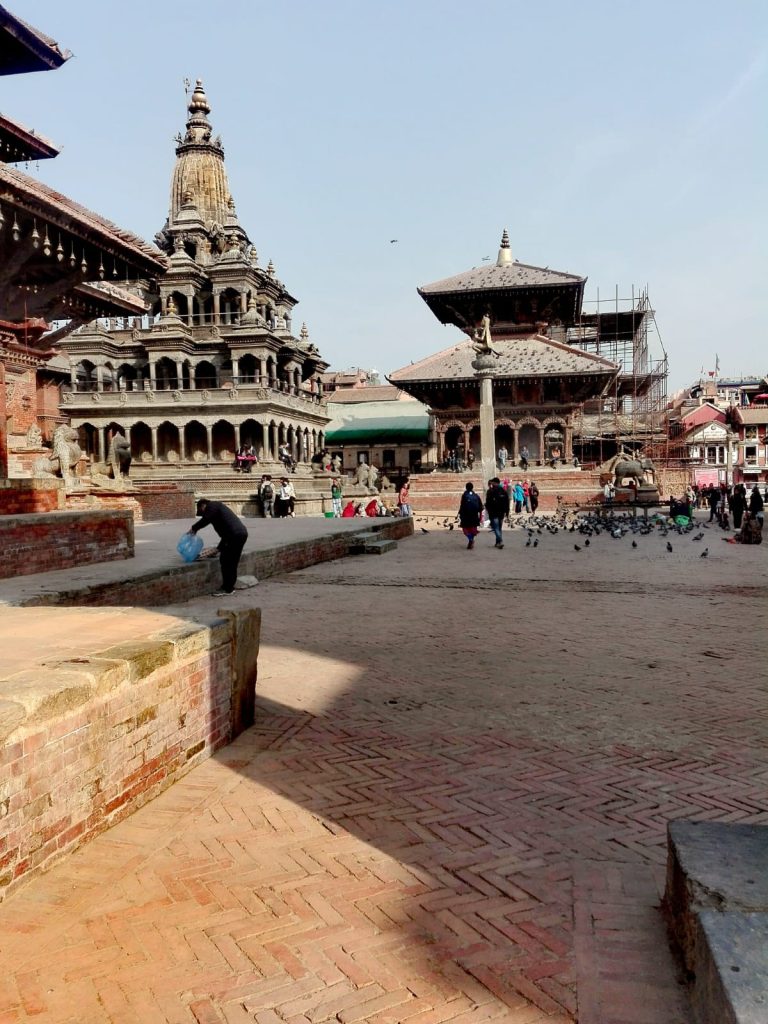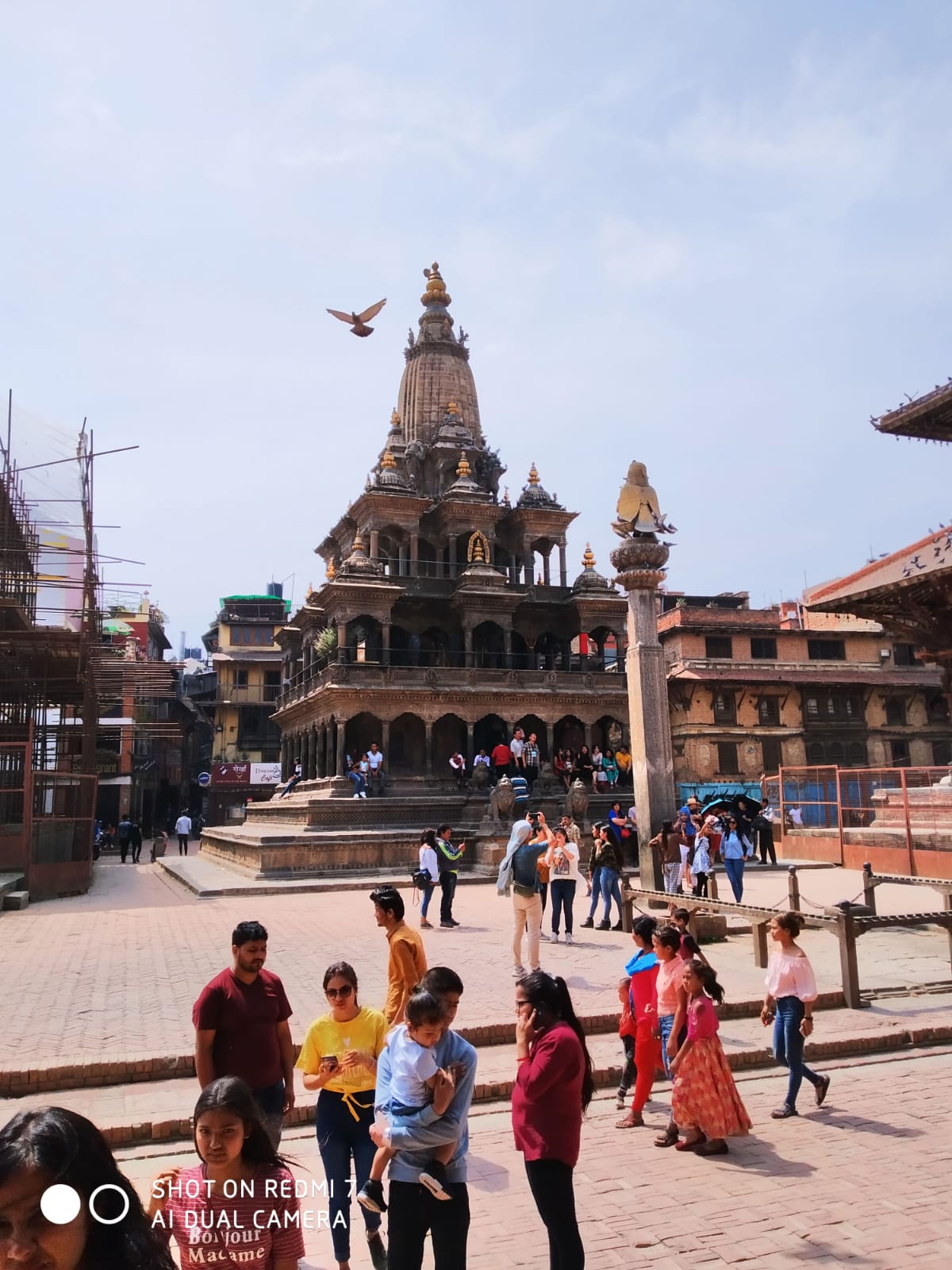
Patan Durbar Square, located in Patan, Lalitpur, Nepal, is a favorite destination for both locals and tourists. This UNESCO World Heritage site is surrounded by embassies and a court of law. This historic square used to be Prithvi Narayan Shah’s palace, and is perched atop the disturbing Malla kings. In this context, this system couldn’t even unbend any history worth mentioning. Detailed knowledge of the cultural anthropology of this area of civilization tells us that the development activity is properly encouraged. The square has many temples, statues, courtyards, traditional houses, and other historical and religious heads. In this all-inclusive guide, we will examine the most important periods of Patan Durbar square history, appreciate its breathtaking grand architectural heritage and enjoy the amazing cultural practices that are still present at this old and wonderfully culturally endowed place.
Historical Significance of Patan Durbar Square
Patan Durbar Square is recognized for its rich heritage and is considered one of Nepal’s must-see sites. Constructed during the Malla era, between the 16th and 18th centuries, this square became a hub of art, culture, and governance. The Malla rulers, known for their architectural expertise, adorned Patan with grand shrines, royal palaces, and courtyards. Among the notable structures are the Krishna Mandir and Bhimsen Temple, both remarkable examples of Malla-era architecture. Patan Durbar Square also became a stronghold of Newari traditions, serving as a center for arts, religion, and the Newar guild system. Its historical significance and cultural richness have attracted visitors from around the world, showcasing the exquisite art and architecture of the Malla dynasty.
Malla Dynasty and Its Legacy
The Malla rulers, in power from the 12th to the 18th centuries, were instrumental in shaping the cultural landscape of Nepal. During their reign, the Kathmandu Valley experienced a cultural revival, marked by the construction of temples, palaces, and public squares. Patan, one of the three ancient cities in the valley, flourished under the Mallas’ patronage. The rulers were not only political leaders but also great patrons of the arts. Their era witnessed the creation of unique and lasting architectural and artistic works, which continue to define the cultural life of the valley today.
Architectural Marvels of Patan Durbar Square
Patan Durbar Square showcases intricate architecture, featuring large temples and grand palaces. Each structure includes various styles such as pagoda, Shikhara, and Stupa. This diversity enhances the cultural richness of the square.
Temples and Stupas in the Vicinity of Patan Durbar Square
- Krishna Mandir: Krishna Mandir is dedicated to Lord Krishna and a properly preserved historical monument located in Patan. The town of Nepal at the present day was built in the seventeenth century by King Siddhi Narasingha Malla. This temple is a classic example of Shikhara structure. Topped with 21 spires, the temple has exquisite stone work with carved panels with scenes from Vaiavyana and Ramayana. The Malla kings valued there construction with such materials as legumes, sugar molasses and even vermillion powder. Portrayed, carved statues reads Indian epics. Krishna Mandir still retains its appeal even during slow hours in the late day used to reflect when the calming activity in the temple surrounds them.
- Ashoka Stupa: Having gone on a pilgrimage in the year 250 BC, emperor Ashoka managed to build five stupas in Patan. These stupas, which are in Yamputhur, Lagankhel, Gwarko teta, Pulchowk and Pim baha, rank among the very first Buddhist structures found in Nepal. They show the expansion of Buddhism and also have important religious functions. As for the stupas themselves, with a calm atmosphere all around, they tend to inspire visitors to come up with pleasing contemplation about their temple history and their higher purpose.
Palaces and Courtyards in the Vicinity of Patan Durbar Square
Patan Museum:
Located at Keshav Narayan Chowk, Patan museum was once the palace of king siddhi Narsingh Malla. It houses a superb collection of antiquities especially stone and metal art works paintings and inscriptions. The Patan museum is most well-known for its Hindu & Buddhist art, thus it renders a comprehensive understanding of the glorious aspects of these sects. The patrons appreciate the Patan museum for its careful and effective organization and display of the artifacts. It is so easy to take a step back into the rich artistic history of Nepal, and this is, in part, thanks to the Patan Durbar Square
- Sundari Chowk: Sunder chowk is adorned with beautiful wood carvings; it is also Ain Tusa Hiti in Newari which has a main water-spout and a number of idols. There is also a stone bed in this nice courtyard, containing Penance of King Siddhi Narsingh Malla which is another highlight of the place. The woodwork on the interiors of the Sundari Chowk displays the deft handiwork of the Malla period. Every single piece of artistic embellishments is intrinsic of the age, thereby making sundari chowk an invaluable heritage site within Patan Durbar Square.
- Golden Temple (Hiranya Varna Mahavihar): This temple situated in Kwabahal Tole was constructed in the 12th century and is known for its beautiful copper covering. It houses an exquisite figure of Shakyamuni Buddha which most visitors admire. The Golden Temple demonstrates that it is a courtyard temple because it has Lokeshwor Gumba on its premises. Several styles of architecture popular in the religious buildings of Patan Durbar Square are extremely well seen in Golden Temple. The gold-plated structure which harmonizes decorous environment and precise naksha leaves strong impression both as creation to sluice and to study allowing the followers to encounter spirituality and art within Patan Durbar Square.
Cultural and Religious Significance of Patan Durbar Sqaure.
Patan Durbar Square performs a dual function as a religious and cultural center drawing of devotees and tourists in simultaneously with people of the locality. There are many temples and shrines within the square and each is of great concern. Most of these are fully functional and are used for worship and important local cultural events that have been going on for centuries. People of Patan usually integrate their activities, architecture and religion. This is well demonstrated within Patan Durbar Square which has copious amounts of cultural and religious traditions.
The Living Goddess (Kumari)
One of the most fascinating aspects of Patan Durbar Square is the tradition of the living goddess, Kumari. This young girl, selected for her divine features, is believed to be the living embodiment of the goddess Taleju. She resides in Kumari Ghar, near Patan Durbar Square. The selection process for the Kumari is meticulous, requiring perfect physical and emotional qualities. Once chosen, the Kumari plays an active role in religious ceremonies until she reaches puberty or suffers a significant injury. This unique tradition highlights the deep religious and cultural practices of Nepal and is a major attraction for visitors to the square.
Banglamukhi Area
Walking just a short distance from Patan Durbar Square, the Banglamukhi area is of religious significance and there are a large number of people coming ay to worship. The prominent temples in the area include Banglamukhi, Kumbheshwor Mahadev and Manakamana that are each claimed to possess image that were materialized in mystifying circumstances. Each of the temples is not only an edifice for or some monument for worship but an essential part of the cultural heritage surrounding Patan Durbar Square. Every day worship, offering and gatherings take place in the Banglamukhi area making it an important part of the culture and religious aspect of Patan Durbar Square. One can take a stroll in this active area and also feel the intense spiritual link between Patan Durbar Square and its surroundings.
In this way Patan Durbar Square remains and active centre of pilgrimage Christianity giving an elaborate picture of what the people cultural and spiritual insight pertaining to Patan.
Key Figures in Patan’s History
Several historical figures have shaped the legacy of Patan Durbar Square.
King Siddhi Narsingh Malla
King Siddhi Narsingh Malla, the first Malla ruler of Patan, made significant contributions to the city’s architectural and religious landscape. He was born in 1606, ruled for 42 years, and practiced his religious beliefs with great devotion. His legacy includes the construction of Krishna Mandir and numerous other structures. King Siddhi Narsingh Malla’s reign was marked by a commitment to enhancing Patan’s cultural and spiritual life, leaving a lasting impact on the city’s architectural heritage.
King Yog Narendra Malla
Malla, who ruled from 1667 to 1705, was a prominent figure in Patan’s history. His reign was marked by religious devotion and significant architectural contributions. The statue of Yog Narendra Malla stands atop a pillar near the Jwala Narsingh Temple, alongside his son Siddhi Narsingh Malla II. King Yog Narendra Malla significantly contributed to Patan’s artistic and religious traditions during his reign. His efforts reflect a strong commitment to both spiritual and civic development.
Temples and Shrines Around Patan Durbar Square
Beyond the main square, Patan is home to several important temples and shrines.
Mahabuddha Temple
Craftsmen built the Mahabuddha Temple in 1508 AD, showcasing remarkable Buddhist art and architecture. Additionally, they took 36 years to complete it, drawing inspiration from the Mahaboudhdha Temple in Bodhgaya, India. The temple features numerous Buddha images and a small shrine dedicated to Buddha’s mother, Maya Devi. The Mahabuddha Temple is a significant example of Nepalese Buddhist architecture, representing the rich tradition of Buddhist art and devotion.
Rudra Varna Mahavihar
Rudra Varna Mahavihar, located south of the Mahabuddha Temple, is an ancient Buddhist monastery adorned with intricate statues of peacocks, elephants, and Garudas.This monastery is a significant site for both local and international visitors. Its architectural features and religious artifacts provide valuable insights into the historical development of Buddhism in Nepal.
Red Machhindranath Temple
The Rato Machhindranath Temple, located 200 meters west of the Mananath Temple, is notable for its three-storied pagoda style and metal roofing. Rato Machhindranath festival is celebrated for two months. The Red Machhindranath Temple is a vibrant center of local religious activity, reflecting the deep cultural and spiritual traditions of Patan.
Additional Attractions and Activities of Patan Durbar Square
In addition to the above-mentioned historical sites, there are various attractions and activities that Patan Durbar Square tourists can partake in.
Local Markets and Crafts
One of the great experiences is venturing into the local markets around Patan Durbar Square. Such markets are very active. Artisans are displaying the handmade ornaments, piece of cloths and traditional art work. Those who visit Patan will find memories and gifts pertinent to the arts of the town. It is interesting to talk to the craft makers and learn about their art and craft practices. This popular market is the showcase of the skillful art products of the region.
Cultural Festivals
Patan Durbar Square is bustling the whole year round because of the numerous cultural events that take place. Indra jatra, Krishna Janmashtami, and Tihar are among the events which people as well as visitors come for. It is indeed praise worthy that there are beautiful traditional dances along with the wonderful parades and the pious activities in these festivals. Visitors get the opportunity to witness and understand the activities at first hand. There is nothing more gratifying than being part of such activities and seasonal events in Patan.
Culinary Delights
Food is an additional component that one should recognize when one visits the area around Patan Durbar Square. There are plenty of food types available. Traditional Newari dishes, which visitors may find as mouthwatering, are here for the dining pleasure. Local joints serve appetizing momo, dal bhat, and other local delicacies. Having the food in such a vibrant atmosphere adds to the whole experience. Each piece reflects the culture and diversity of cuisines in Patan.
Art and Architectural Excursions
And for those who appreciate the art and architecture in its various forms, Patan Durbar Square has walking tours on offer. These tours provide adequate information about the beautiful temples and the palaces around the area. Visitors can learn more about different styles of architecture as pagoda and Shikhara types. Very passionate people guide visitors throughout the sites and explain the most interesting stories about both sites and objects behind them. This is not only a learning but an appreciation exercise that immerses people within the artistic environment of Patan.
Concisely, Patan Durbar Square is not simply a monument. It is active and full of life – culture, art, and people. Its local markets, festivals and good food are just a few of the things that can keep one busy. There are various things that would can promote and showcase the traditions of Patan. The whole journey builds patience and further down, makes Patan Durbar Square in the top list of every tourist in and around in Nepal.
Practical Information for Visitors in Patan Durbar Square
For those who intend to spend some time at Patan Durbar Square, here is some practical information.
Entry Fees and Tickets in Patan Durbar Square
Visitors from abroad should note that they must pay an entrance fee to visit Patan Durbar Square. This fee helps fund the site’s conservation and maintenance. You can purchase tickets at the entrance or from licensed agencies. Ready ticket allows bypassing waiting lines. It will also assist Sri Mahabouddha in his efforts towards the protection of both the architectural and cultural heritage of the square.
Best Time to Visit
There are also other times that would be appropriate for visiting Patan Durbar Square, however, the months between October to March are the best. During these months also, the weather is cool and comfortable. This is what makes this time favorable for visiting places with a rich history. Preferably do not travel during the rainy season, consisting of the months of June – September. Chances of heavy showers heighten and may frustrate travelling endeavours and excursions too. Going in the cooler seasons allows you to witness their local cultural activities, which gives the trip an added extra flavor.
Guided Tours and Maps
Patan Durbar Square is a treasure trove of historical, architectural, and cultural marvels. Patan Durbar Square features ancient temples, palaces, vibrant festivals, and revered figures. It offers a profound glimpse into Nepal’s rich heritage. Whether you’re a history enthusiast, an architecture aficionado, or a cultural explorer, Patan Durbar Square promises an enriching experience. You will connect with Nepal’s illustrious past.
The historical significance and architectural grandeur of Patan Durbar Square make it a must-visit destination. Anyone interested in exploring Nepal’s rich history and heritage will find it captivating. Its blend of ancient temples, royal palaces, and vibrant cultural life creates a unique and immersive experience. Patan Durbar Square is truly a remarkable destination, offering various workshops that are both engaging and fascinating. These places provide a closer view of the exquisite local art present in Patan. Patan Durbar Square is a stunning site. Additionally, this location offers beautiful architecture, which is why it attracts many visitors. Moreover, its rich history makes it even more captivating.”

